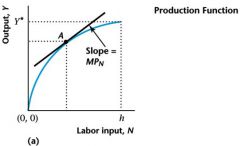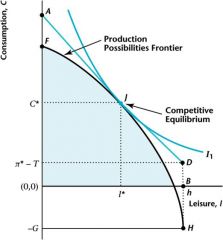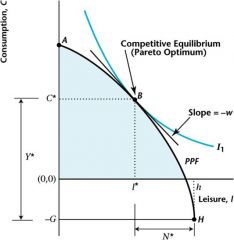![]()
![]()
![]()
Use LEFT and RIGHT arrow keys to navigate between flashcards;
Use UP and DOWN arrow keys to flip the card;
H to show hint;
A reads text to speech;
17 Cards in this Set
- Front
- Back
|
Competitive Equilibrium steps
|
Representative consumer optimizes given market prices.
Representative firm optimizes given market prices. The labor market clears. The government budget constraint is satisfied, or G = T. |
|
|
Income-Expenditure Identity
|

|
|
|
Equation 5.3
|

|
|
|
The Production Function In equilibrium
|

|
|
|
Figure 5.2A The Production Function and the Production Possibilities Frontier
|

|
|
|
Figure 5.3 Competitive Equilibrium
|

|
|
|
Equation 5.6: Key Properties of a Competitive Equilibrium
|

|
|
|
First Welfare Theorem
|
First Welfare Theorem: Under certain conditions, a competitive equilibrium is Pareto optimal.
|
|
|
Under certain conditions, a Pareto optimum is a competitive equilibrium.
|
Second Welfare Theorem
|
|
|
Figure 5.5 Using the Second Welfare Theorem to Determine a Competitive Equilibrium
|

|
|
|
Effects of an Increase in G
|
Essentially a pure income effect
C decreases, l decreases, Y increases, w falls |
|
|
Effects of an Increase in z (or an increase in K)
|
PPF shifts out, and becomes steeper – income and substitution effects are involved.
C increases, l may increase or decrease, Y increases, w increases |
|
|
Equation 5.7: Production function without capital
|

|
|
|
Equation 5.8: Production Possibilities Frontier
|

|
|
|
Equation 5.9: Consumer’s budget constraint
|

|
|
|
Equation 5.10: Profits for the firm
|

|
|
|
Equation 5.11: The consumer’s budget constraint in equilibrium
|

|

